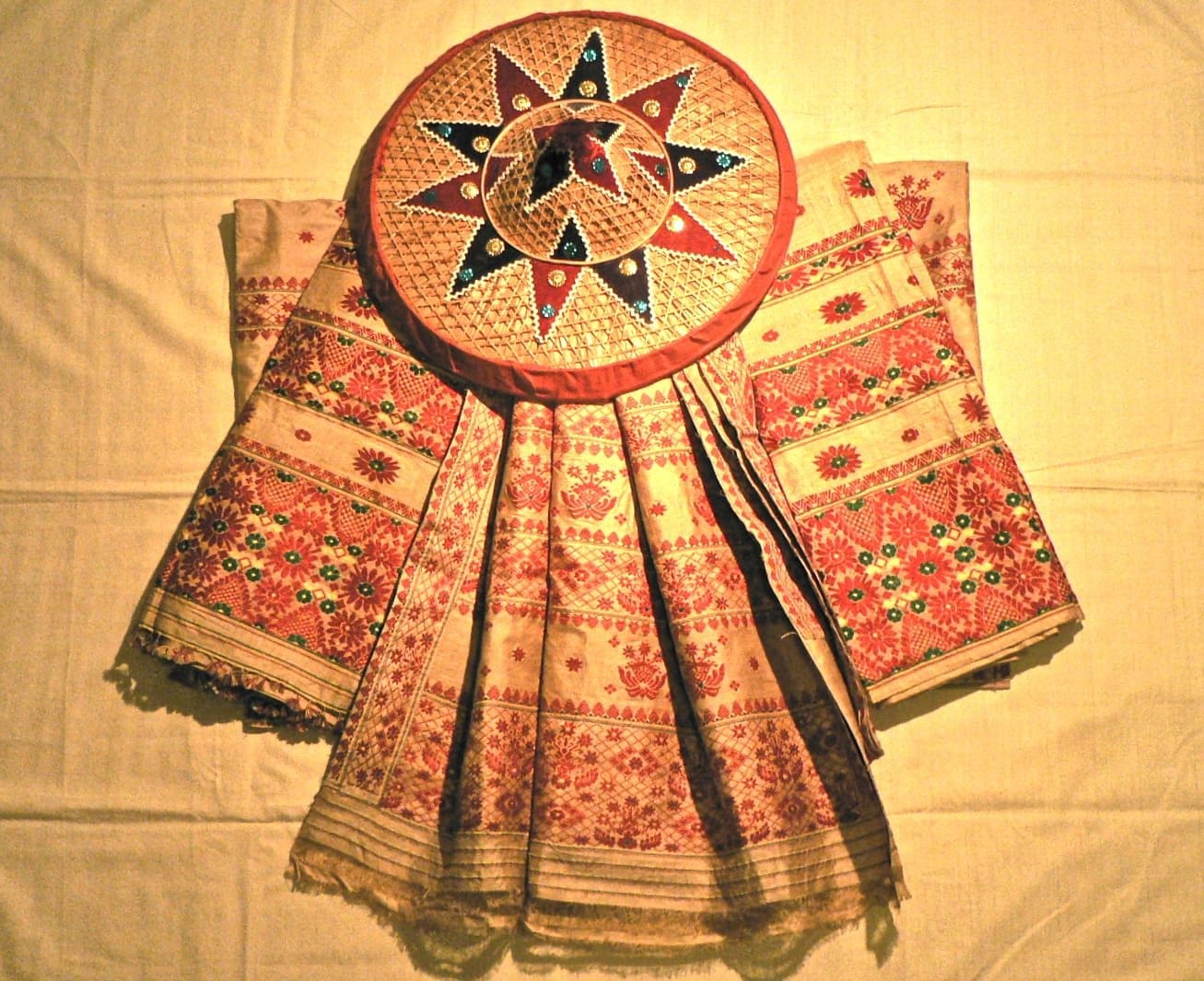INTRODUCTION
Clothing is one of the most important primary needs of human being. This relation of mankind with clothing is the relation with his body and soul. To known human culture clothing plays a very vital role. It is due to the fact that clothing only not only cover our body but also covers the vast arena of human culture. It is clothing that expressed the tastes and choices of people. As mentioned earlier during the stone age people used to wear bark and dry skin of animals to protect them from heat and cold. With the progress of human civilization this place has been occupied by handloom weaving. With the passage of time people have learnt to apply different colour in wearing. This resulted in coming out of multicoloured and beautiful clothes. Thus it has been noticed that with the change of motives of the people there has been a great deal of changes in taste of choices. Likewise there has been changes in culture also. Side by side the pattern of day to day life of people has gone under great changes. Culture has become dynamic. This human culture nicely reflects human thoughts, tastes – temperament, beauty, the tradition and so innovative thinking. This evaluation of many weaving culture has tremendous effect on culture and life. It is known that Chinese queen Lingchi discovered the silk clothing five thousand years ago. From China this weaving of silk cloth transported to Rome. It is also known that some prince of Kashmir married a Chinese princess and the prince is said to have brought silk cocoons to India. The tradition of silk and Muga cocoon has been old culture of every Assamese household.
TEXTILES
Churia or Dhuti
It was an unstitched main male dress in medieval age. It was 8 to 16 cubits long and from 2 to 2.25 cubits wide. It was plain and free from any decoration. A few ethnic groups were woven endi-dhuti for cold season. The cloth was worn round the waist and hanging down to the knee or below it. At the beginning, this „churia’ or „dhuti’ was held tight round the waist with a sort of girdle called „parivesa’, which was also known as „Komarbandh’ (like modern belt). In this period, the higher officials, the head of the satras and Brahmin used silk and muga churia, which extended below the knee. In religious function or to worship of God, red coloured silk dhuties were mostly preferred by priest. According to the Guru-charit, the „churia’ was called as „Bhuni’

Mekhela
In medieval age it was the main female dress. It was worn round the waist and covering down to the ankle-joints with giving 2-3 plaits in the front. It was worn in combination with chaddar. When it was worn round the breast and covers down to knee then the style was called „methoni mara’ which followed by different ethnic groups of Assam. The idea of „mekhela’ originates from the Vedic word „Mekhola’

gra, Ghuri and Ijjar
Like other part of India, the ghagra was a waist cloth used in different theatrical performance i.e. bhaona and band singers. Ghuri was a skirt like lower garment. Material used for ghuri is pat silk yarn. The sutradhara of Bhaona and Gayon Bayan or Yoja (the members of the band of singers and dancers) wore Ghuri. The dancer was called „Natua’ in the satras. The ordinary dancers who take participate in Bihu dance also used Ghuri. It is adorned with a border of floral design at the lower. Alongwith ghuri the Satriya dancer used Kanchi a waist gear. It is an accessory of the waist. It is made of three U-shaped pieces joined together by a band at the waist which is stitched to it. It is adorned with borders of floral designs.
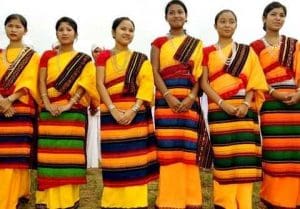
Cheleng
It was a white plain longitudinally woven sheet of cloth. The cloth was six cubits in length and 3 cubits in breadth having the two ends embroidered with muga yarn or golden thread or other coloured thread or sometimes without any decorative work. The one end of these costumes was hung to the front over the left shoulder taking it across the back under the right arm and hung over the left shoulder to the back. In medieval age it was a popular costume amongst the male. The silk cheleng (patar-cheleng) was worn by bridegroom as part of the wedding dress.

Chadar/Upreni
The chadar (popularly called upreni in Lower Assam) is an unseen item of Assamese women‟s dress. It is worn in such a fashion that one part wraps the upper part of the body while the other part is draped over the mekhela. Married women use the free end of the upper part as a veil over the head. Wearing of chadar (along with mekhela and riha) has distinct connotation of decency and modesty in plains Assamese culture. The chadar traditionally of the size 2.75 x 1.25 metres in generally woven out of fine cotton yarn, occasionally blended with rayon and acrylic yarn in present days. Muga and pat silk chadars were also woven by the Assamese weavers till very recent years. These days such chadars are not produced much in the home looms. Like silk mekhela, the production of silk chadars now is largely a commercial affair in silk producing centres at Sualkuchi and other production centres. The design used in mekhela is woven in the chadar to make a complete set. But chadars are also woven as separate pieces to go with any mekhela chadar.

Eri-chadar (Eri shawl)
Eri-chadar is woven out of eri silk in the size 2.75 x 1.35 meters for men and 2.00 x 1.00 metres for women. It is used as a shawl in winter. Eri-chadar is an important item of textile among the plain Assamese as well as many other neighbouring communities. It is very much in demand in the entire Northeastern region. The hill tribals of the neighbouring region covet eri-chadar very much. This way, it may be regarded as an element of inter-cultural unity.
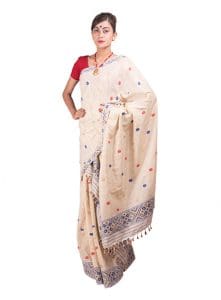
Riha / Augron
It is a fairy thin cloth of approximately 3.25 x 0.70 metres size. Riha is a typical and traditional item of women attire. It is worn as a wrap around the upper part of the body usually beneath the chadar to cover the breast region. A part of the riha is tightly passed over the loin region and tied around the waist. Worn this way, the riha is supposed to tend to the shapeliness agility of the frame. In the olden days Assamese women did not use blouse and hence, riha was the formal breast cover. For most of the women riha is not part of everyday wear these days. Riha with its distinctive mode of wearing, makes the dress of an Assamese women graceful. It is an important item of bridal attire. It is also much valued as an item of dress of married women on ceremonial occasions. Riha is woven out of cotton, muga and pat. Rayon is also used occasionally with cotton. Riha is popularly called augron in Lower Assam.
Khania
It was a double folded wrapper having flowered border or golden thread (guna shutar phull) at the end of one fold, instead of cotton yarn. It was altogether 12 cubits in length and 3 cubits in breadth. The decorative works had been seen at the two ends of Khania cloth with muga and golden thread. Sometimes eri yarn was also used in making of this cloth. Designs with geometrical motifs, flowers, trees, creepers were woven with muga or golden thread as cross-borders. Small motifs also used as butis for additional ornamentations. In medieval age, the higher officials or high-ranking people, both male and female used Khania woven with silk yarn. The Khania used by female is called as “Pakhila Ura Kapor’, which used over riha instead of chadar at the time of social and religious occasion, (Barua Bhuyan 2003, p.24) it was a costume that the married Hindu women present one Khania bastra to the satra to her „Guru’ or God. This is required as a mark of respect for the Guru‟s or God. Such offerings are made on other occasions also. It is moreover, a piece of fabrics with distinctive status connotation. Traditionally it is considered most appropriate for a newly married girl to present a Khania-barkapor to her in-laws as a token of respect.
Gamocha
Gamocha is basically a textile item which is used to wipe the body and face. But it is a piece of cloth, having multiple uses and meanings. Gamocha is an indispensable part of Assamese life and culture, intricately and intimately woven into the social fabric of Assam. It is not merely an item of multipurpose physical convenience. Its services extend far beyond the body into the sphere of mind and soul (Das N.D). It has come to acquire distinctive symbolic significance in the non-tribal plains Assamese socio cultural life. In many rural Assamese homes, weaving of gamocha is a must even if the loom is not used for other textiles. The women also lavish considerable care and attention in weaving intricate designs along the cross borders of gamocha. Gamocha is woven out of mostly 40s, 60s cotton. Occasionally 2/80, or 2/100s Cotton are also used. It is woven invariably in white with red as side and cross borders. Floral designs are woven as cross border at one end. The other end is finished with a plain border of the same colour. Use of colours other than red in the boarders is often noted in lower Assam. The cultural importance of gamocha can easily be appreciated from the different names it has, one for each of its varied utilities.

The bihuwan and tangali gamocha’s position is highest among the indigeneous fabrics of Assam. As the name implies behuwan derives its importance form its association with Bohag-Bihu (also called Rongali bihu), the most focal and lively of the festivals of Assam. It is the festival in which the onset of the Assamese New year, beginning in the month of Bohag (mid-April) is celebrated. On such occasion, respect for elders, affection for the young, love between young men and women blossom into ceremonial expression. That expression takes the form of a presentation of the bihuwan, however poor a family may be usually gamocha is woven at home by the womenfolk. Weaving of gamocha before the celebration of Bohag-bihu is special feature of Assamese culture. It is still a distinctive practice prevalent in the rural people of Assam. In the original concept, tangali represents the love of the mother for her warrior son and the wife for her husband going to the battle field. It was believed that this piece of cloth, where every thread is charged with potent love of a mother or a wife, would protect the son or the husband from dangers in the battlefield. At present tangali has acquired a new significance as another type of bihuwan (bihu gift). It graces the waist of the bihu dancer as a girdle. Gamocha is used as a turban cloth by men on such festive occasions with the flaps flaunting at the side. The gamocha now-a-day has become an additional item of dress. On festive or ceremonial occasions, it is neatly folded and worn around the neck. Further, it is customary to offer the gamocha to distinguished guests invited to the sociocultural and religious functions. The gamocha is widely being used as an item of cultural identity of the plains Assamese. It would not be wrong to say that gamocha has become a visible symbol of Assamese ethnic identity.
Anakata
Anakata literally means „un-cut‟. In the loom, the standards of yarn at both ends of the woven fabric are not cut when the weaving is over. Instead the woven fabric is freed from the loom by loosening the knots from the reed and other accessories of the loom. Only one piece of auakata cloth is woven at a time in a loom. Anakata cloth may be a chadar, dhuti, saree, gamocha or a bihuwan each having its cultural significance in different socio-ritual occasions among the Assamese-Hindu people of Assam and in Hajo. A lot of hard work goes into weaving this cloth. Further, this has to be woven very smoothly, evenly and without causing any damage. It has its significance as ceremonially pure cloth called yatrar-Kapor and is prescribed with care.
Chola (shirt)
In medieval period, men used different kind of shirts. But, the women-folk when began to use blouse or other jacket type cloth, it has, no any definite records. However, in the book- „Puraani Asamar Silpa’ (Handique, 1959: 57) stated the use of a kind of blouse with long hand and ornamented with flowers off golden threads. Generally, aged women worn long sleeves blouse. (Ahmed 2006, p.65) Instead of that the women also used a round-necked and half sleeved blouse where the ends of the sleev adorned with a border of floral motifs. The history reveals that the Ahom king Rudra Singha first brought to Assam the specimen of shorts of different colour and design from different provinces of India. Probably, Muslim women first introduced stitching cloth, amongst the Assamese people. They prepared „Anchali chola’ (a shirt for a region), male shirt and Oronikani (a vail cloth for women). (Phukan 1987, p.30) The king, ministers and other high officials began use shirt which known as „chauga’ and „chapkan’ in the style of the Moghals. Different types of male shirt used in medieval period were – Engachola (it is a tunic type vestment, reaching to the knee). This type of long Robe generally made by muga cloth. Buku-chola (it reaching to the waist and the sleeve were extended up to the elbow, Mijai-chola (a sort of coat or jacket like the bukuchola), chapkan (a kind of surcoat (over coat) or robe reaching to the knee, used by the officials only. The Ahom king also used chapkan made by kingkhab, majankari and gomseng silk yarn which decorated with golden thread), chauga (it is a cassock like drapery, worn over the chapkan), Rupar-beridia-chola (a kind of costly shirt bordered with silver worn by kings), Jama-chola (an ornamental shirt used by bride groom), Phatuwai (an ordinary type of shirt popular among the common people), Gom-chengchola (this type of shirt was made with fine Chinese silk having designs of followers like those on the body of the snake called Gom), Jali chola (net type garment) khara chola’ (this garment impregnated with alkali), Hallow chola (the grandmother of Assamese family generally used this type of sleeveless hallow chola (a maxi type short) under riha, chadar and mekhela to cover her whole body.

Tangali (Girdle)
The tangali was a piece of cloth about 4 to 5 cubits in length and about 2 (two) cubits in worth. The ends of cloth extremely ornamented with coloured threads. It was a waist wrapper worn by males or used as belt to gird the waist and the two decorated ends suspended on the front. It was made from varieties of silk such as mulberry silk, muga and endi. Sometimes cotton yarn also used in tangali (west band). The two ends of tangali trimmed with fringes besides having floral motifs. The young boys tied red tangali on their waist when they performed bihu huchori. The white tangali was one of the special value added clothes used in satriya dances. The front of the tangali beautified by dohi knitting. Some people called tangali as „Anna kapor’.
Designs and Motifs
The term design is used to convey different meanings. In a broad sense the term implies a composition produced by integration of different elements for some specific purpose or intention. Design in a general way is divided into five broad categories, viz, naturalistic, stylized, geometric, abstract and structural. Naturalistic designs are those that are drawn from flowers, leaves, plants, animals, landscapes etc. The motifs are kept realistic to provide an authentic image of nature. In stylized designs the motifs do not exactly maintain the image of the natural object. Usually, the lines are simplified and conventionalized. At Sometime the lines are also distorted.
Geometric designs are based on the true forms of circle, square, triangle, rectangle, diamond shaped etc. Endless variations and combinations of these basic geometric forms are used. Although many geometric designs are derived from nature, these cannot be easily related to their respective natural sources of inspiration. The term symbolic is applied to such arrangements. The use of symbols to express ideas thoughts or wishes is termed as symbolism. Abstract designs are mostly based on geometric forms, yet the abstract implies an element of impressionalism and a greater freedom as compared to most geometric designs. The designs are called structural when the structure of an object forms the design. Simplicity is the main feature of structural design. Ornamentation of handloom fabrics in the region is done in the loom itself and embroidery as a mode of ornamentation is not commonly found. However it is evident from historical records that embroidery with the needle was introduced in the Assamese textiles with the advent of Muhammadans. This particular type of needle embroidery, once famous and practiced till recent past, is called Karchip work. It is done with flat silver thread and generally on fine cotton cloth (traditional Assamese textiles in which ornamentation is done on the loom itself and with Karchip work respectively Picture) Not only decorative motifs or designs, colour too plays a vital role in the textile tradition of Assam. But indigenous weavers produce attractive designs of various shades in different textile items. The emphasis on weaving attractive designs has always been a characteristic of this craft in the region. The creative urge of the women and their eye for beauty found expression in embellishing even such a simple, functional piece of textile like gamocha as discussed earlier with captivating motifs and designs.
Floral and plant motifs
The floral and plant motifs offer unlimited scope for the adornment of textiles. Flowers from the simplest and smallest configuration to those with welldefined petals are found in the textiles of Assam. The simplest floral motif found is a small circle or dot with short radiating lines on all sides. This seems to be most popular in the region. Some of the common flowers such as Champa Michelia chamnaca), Gutimali, Nahar (Mesua ferrea) etc. are mentioned clearly in Assamese folk songs which is related with traditional weaving. Aou-phul (flower of Dillenia indica) is found to occupy a vital place in the textile design in the study area. Big bold flowers in stylized and geometric forms, which used singly as buta or as a unit in the design, are often found in the textiles in the region. Some of them are categorized as wild flowers without any specific name. it is regarded as a symbol of success. It is still used in the Golaban (presently called aronai) which has the distinct cultural significance. Padum (lotus) and golap (rose) are two flowers commonly found in the textiles produced traditionally in the region. These two flower motifs are however never used in mekhela traditionally since these are generally used in fabrics of religious importance.
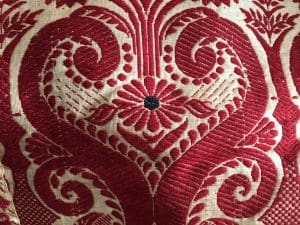
Animal Motifs
A variety of animal motifs like butterfly, peacocks, elephant, tiger, fish etc. cleverly adopted in stylized form with a minimum of lines occupy an important place in the textile design of Assam and particularly in the area under study. Charai (birds) in general, mora-charai (peacock), hanh (ducks and swan) are common motifs in the textile design the region. Peacock, duck and swan are regarded as sacred motifs by the Assamese Hindus. The border design of cloth used in places of worship often has the peacock motif in combination with other motifs. The swan, in combination with lotus motif is also used on similar sacred cloth by the Assamese) people in the region. Such clothes are referred to as gosain-kapor (cloth meant for God). The two moras (peacock) facing each other forming an interesting design is named juria-mora. Uses of bird motifs symbolizing vimra (a species of the bird of paradise) among the karbis and machruka (kingfisher) among the Rabhas have deep socio-cultural significance. These are regarded as sacred birds connected with the myths regarding origin of the tribes. Fish, lion, tiger, elephant, deer, goat etc are other animal motifs in highly stylized form found in the textiles in the area. Fish, lion and tiger are rarely seen in the textiles of the area under study. The old designs catalogues depict the lion simply or in combination with the peacock . Some of the animal motifs found in the textiles of Assam. Although the cat and bear are not seen as motifs in textiles yet such motifs are weaved in the loom hanging in the drawing room and reflects so much beauty in the motifs. The human figure like bihuwaty (dancing bihu dance), some women sitting in her loom or as a man riding a horse or elephant appears frequently in the textiles in the area in the old design catalogues.

Geometrical Motifs
Diverse elements of nature seem to be the main source of inspiration so far as ornamentation of textile is concerned. It is believed that the wonderful unity, orderliness, harmony of line and curve, the symmetry of form and shape which are all intrinsic characteristics of nature have inspired the geometrical designs (Mazumder 2013:133). Geometrical forms have been used for fabric ornamentation for a very long time in various cultural settings. In the textiles of Sualkuchi also geometric designs, individually or in combination with stylized motifs have been used widely since the olden times. When old pieces of textiles in the different study groups are examined, these are frequently found to be richly ornamented with various types of geometric designs. Such lavish and frequent use of geometric forms is a clear indication of their popularity. The small diamond motif with a dot in the centre is very commonly found in textiles in the region. It is called gunaphutuki by the plain Assamese. The term literally means „gold dots’. Another design having a diamond within a diamond with a dot in the centre is named daothogodo by the Bodo-Kacharis. It symbolizes the pattern made by feathers in the neck of a dove.

Mode of Preservation of Design
The design are worked by the weavers in the region from the old scraps of design or from a separate design catalogue. Instances of working out the design etched in memory were also found during field investigation. Most of the weavers have a good collection of designs of their own. Among the weavers in the region, the preservation of design itself is an art which evolved through different stages. Information collected from the traditional bearers in this regard revealed that in the olden days the simple design worked on a banana leaf (Kalpat) was given to the young girls for learning the technique of incorporating the design in weaving. Since banana leaf was not durable, the design was subsequently worked on the thick sheath of leaf of areca palm tree (dhakua) shows the preservation of design in the above mentioned methods. With the limitation of preserving design even on the leaf of areca palm tree, the indigenous weavers have developed yet another method. In this, the design are woven on a warp of coarse yarn with fine bamboo sticks or thatching grass as the pick of the design. It is called ghai or kathi-chaneki. The design are generally woven in a narrow width about 40 to 50 cm, while the length varies according to the availability of designs and material. This sort of design catalogue can be preserved comparatively for a longer period. The indigenous weavers consider these catalogues as valuable articles and would never part with them. Such design catalogues are not generally made nowadays. The weavers collect the designs on net like cloth where the designs are worked with niddle . Use of graph paper to draw the design is also adopted and gaining popularity in the present days. The mode of preservation of design followed by indigenous weavers makes it clear that scraps of designs and old ghais are the main store-house of traditional designs in rural areas. In this context, the danger of disappearance of these traditional designs is looming large. Once the steps of design and catalogues disintegrate and experts are no longer there to properly identify and explain, the designs. The old designs too will face the natural death. This indicates the need for immediate salvage work in the sphere of motifs and designs of Assam alongwith Hajo circle. Revival and scientific preservation of traditional designs is therefore considered essential. Some new designs have found to be evolved from these traditional designs without disturbing its identity and these designs may suitably be used in a range of products for commercial viability and products for different end uses. But in the village Sualkuchi the designs were preserved in card from a very earlier days as it is now also. The cause is that the weaving tradition at Sualkuchi is performed with pat silk and Muga (golden thread). They designed their fabric with the help of card fitted in a Machine called „dobua’. At present also the designs are preserved in the same mode. As the wave of Sualkuchi is spread in the entire Hajo circle the traditional weavers in the region has also been converted their industry to commercialization with Muga and Pat silk and the mode of preservation of design catalogues is also followed as like as Sualkuchi.
Traditional Textile Technology of weaving
The need for costume originated with mankind‟s needs for coverage and protection from elements of nature. Later it becomes a means of adornment to help enhance beauty and reflect social factors such as religious symbol, personal identity and status. For fulfilling our basic needs to cover and protect our body i.e. cloth which is technically known as Fabric. For preparing this fabric the raw materials is yarn. Yarn is manufactured from different types of fibres. These fibres may be mainly originating from nature or it may be manmade. Among the natural fibres cotton is the king of fibers and silk is the queen of fibres. After passing various stages the yarn is prepared from the fibres. To become a textile fibre, the fibres should have some definite properties. From that fibres only the yarn can be prepared. Generally fabric manufactured by weaving techniques basically we require two series of threads, one is longitudinal series, another is transverse series. The longitudinal series is known as warp and the transverse series is known as weft. When this both of series interlaced then the cloth is woven. But before going to weave the fabric in loom mainly the longitudinal threads i.e. warp should gone through some preparatory process. That means the warp thread should be preferred properly when it is to be used in loom. It is well known to us that the yarn supplied to Handloom Industry generally in hank form. This hank form of yarn is not at all suitable to be used as warp bobbins to get a convenient form which can be used in warping process. The preparatory process of weaving are sizing, winding, warping, beaming, looming and getting up. Sizing – Sizing is carried out in that types of yarn which are single weak and ununiform in nature. Sizing is a coating of size mixture which is overlap on the surface of the yarn and it makes the yarn strength, rounder in shape and uniform in diameter. In case of twisted yarn which may be used as preparing the warpsheet sometimes sizing process is done. But generally in case of single yarn only, sizing process is carried out Rice starch is most commonly used in sizing the yarns. In this process, required quantity of water, broken rice and yarns to be starched (by hank) are put together and boiled till the rice is cooked properly. A few drops of coconut oil are often added to make the yarn pliable. While preparing eri or muga yarn for warping, the yarn is soaked for sometime in a light starch solution, but never boiled. Various indigenous substances are added to make the yarn pliable and strong. After being wrung out, the yarns are dressed with indigeneous device hank by hank. This is absolutely necessary in case of fine yarns. These are dried and wound generally on bobbin for warping. Now-a-days readymade yarn for pat or muga fabric has been supplied from outside. Winding – Already it is mentioned that the yarns are supplied to Handloom Industry in hank form. This hank should be transferred to bobbin to make it suitable for warping. At first the supplied hank is mounted on swift and bobbin (i.e. warp bobbin) is fitted on the spindles of winding charkha. By transferring the motion to winding charkha hank is wounded on the bobbins. According to our requirement no of bobbins are wounded by means of charkha in a simple procedure. This process is known as winding. Warping – When required numbers of bobbins or Ugha are made then it is ready for warping process. The bobbins are fitted on creel stand for carrying out the warping process. After fitting the bobbins in creel the ends of the bobbins are passed through the hank frame to maintain the lease. Lease means to divide the warp threads into 1:1 ratio or 2:2 ratio. When the lease is prepared the ends are passed through the dent of the reed according to the denting order. After that the ends are knotted together and put it on the nails of the drum. The length of the warp is depend on the circumference of the drum and section is depend on the count of reed and number of bobbins fitted on creel. When required length and width of warpsheet is prepared then this sheet is ready for beaming.
Denting – In denting the warp threads are drawn through the dents of the reed by two in general and more or less according to the character of a pattern the indigeneous process of denting. It is done with the help of a hook and the yarns are placed on a round bamboo stick. Beaming – The transferring of warp sheet up to the warp beam is known as beaming. Every section of warp is maounted in a stick (the stick may be made of bamboo, iron or wood). Then in the place of lease one pair of lease rods are inserted. Now this warp sheet is warped on beam. Now the beam is ready for next process. Drafting or heald knitting – The strong cotton thread available for the purpose is traditionally used as heald. The twisted cotton threads made out of left over yarns from the looming are also used by the weavers in the areas. The beam, so prepared is then placed just on the floor level against two posts and held tight by fixing it also with two temporary posts. This helps to keep the yarns in uniform tension which is essential in heald knitting. The flat bamboo sticks in the wrap used as lease-rods are kept upward causing a slight opening on it. One end of the heald is then passed through this opening from right to left and the knitting is done with a round bamboo pipe. Looming and Weaving – The warp-beam is placed in the appropriate position of the loom. Warp ends are placed on a round step of bamboo and then tied to the cloth-beam. The reed is fixed in the slay. Typing up of healds is the next important operation in looming. The healds are tied by cords over pulley on top, while at the bottom, the healds are connected to the balanced rods first and then to the treadles. As one of the treadles is depressed, the healds connected with it go down, and those connected with another treadle will go up forming an opening in the warp known as warp-shed. The shuttle with the pick is passed across the shed. Then the treadles are left free and the pick iss beaten up with the slay towards the cloth-beam.
Raw materials Cotton is the major raw materials used in the indigeneous handloom weaving for production of different textile items. In the olden days cotton was grown as a household crop and spun into yarn. But in the recent years, easy availability of mill-made yarns of different counts and varieties even in rural shops and bazaars has lessened the importance of cotton growing and spinning. Silk weaving is a special feature of Assam. It plays an important part on the socioeconomic life of the people in specialized weavers‟ villages of Assam. The following are the three types of silk used in Assam traditionally. Eri silk worm is reared all over Assam. Spinning and weaving are also undertaken by the rearers generally for their own use. Spinning of eri in spindles by the rural womenfolk, including young girls, even while they are on the move is marked as an interesting and unique feature in Assam. Eri silk is used mainly to weave shawls, used in winter. It is also used to weave a few items of dress for occasional wear among the tribal communities. But the age old tradition of producing eri silk yarn at home is slowly on the wane. The gradual disappearance of spinning among the rearers seems to be an important factor affecting the textile tradition and socio-economic life of Assam. Sualkuchi is the prominent muga reeling and weaving centre in Assam. Muga production in Assam appears to have gone down considerably in the recent years. This, together with the procurement of cocoons from faraway places to Sualkuchi and the use of a traditional crude process of reeling, account for the high price of muga yarn. Muga is now the most expensive among the indigenous skills of Assam. As a result, it is no longer within the reach of common weavers. The production of pat silk in Assam is not sufficient to meet the demand of the indigenous weavers. Moreover the rural weavers are unable to purchase the silk yarn brought from outside the state by the traders because of high price. As a result the weavers of pat silk in the study region is suffering in yarn constraints in running the loom.
EMBROIDERY OF ASSAM
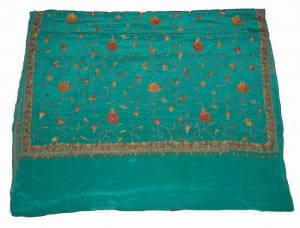
Raw materials Cotton is the major raw materials used in the indigeneous handloom weaving for production of different textile items. In the olden days cotton was grown as a household crop and spun into yarn. But in the recent years, easy availability of mill-made yarns of different counts and varieties even in rural shops and bazaars has lessened the importance of cotton growing and spinning. Silk weaving is a special feature of Assam. It plays an important part on the socioeconomic life of the people in specialized weavers‟ villages of Assam. The following are the three types of silk used in Assam traditionally. Eri silk worm is reared all over Assam. Spinning and weaving are also undertaken by the rearers generally for their own use. Spinning of eri in spindles by the rural womenfolk, including young girls, even while they are on the move is marked as an interesting and unique feature in Assam. Eri silk is used mainly to weave shawls, used in winter. It is also used to weave a few items of dress for occasional wear among the tribal communities. But the age old tradition of producing eri silk yarn at home is slowly on the wane. The gradual disappearance of spinning among the rearers seems to be an important factor affecting the textile tradition and socio-economic life of Assam. Sualkuchi is the prominent muga reeling and weaving centre in Assam. Muga production in Assam appears to have gone down considerably in the recent years. This, together with the procurement of cocoons from faraway places to Sualkuchi and the use of a traditional crude process of reeling, account for the high price of muga yarn. Muga is now the most expensive among the indigenous skills of Assam. As a result, it is no longer within the reach of common weavers. The production of pat silk in Assam is not sufficient to meet the demand of the indigenous weavers. Moreover the rural weavers are unable to purchase the silk yarn brought from outside the state by the traders because of high price. As a result the weavers of pat silk in the study region is suffering in yarn constraints in running the loom.
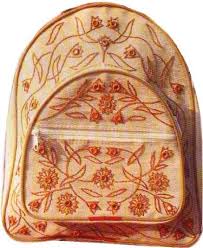
COSTUMES OF ASSAM
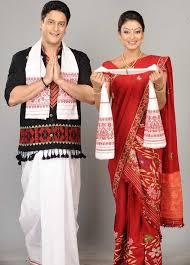
Assam has a rich culture,textile and tradition. Its dresses include Golden Silk Fiber or Muga. These costumes have a lot of demand not only in India but other parts of the world as well. It is really difficult to not see a lady wearing “Muga” or “Mekhela Chadar”. The dress is simply superb with stylish designs. In order to create the clothing of Assam, “Paat” and “Eri” are used. Eri is used to create winter clothing particularly shawls known as “Eri Chadar” and Paat is for creating “Mekhela Chadar”. Both of them look exception on women.
Costumes of men
The Dhoti and Gamosa are said to be the native dress of the men of Assam. The Dhoti is used to cover the lower half of the body and is a well-known piece of clothing in other Indian traditions too. Wearing a Dhoti properly is not so easy and carrying it is also one tricky job. The Gamosa is a rectangular piece of cloth that is an important and significant part of the Assam culture. Gamosa means ‘A cloth to wipe one’s body’ and is a white cloth with a beautiful red border on three sides and woven motifs on the remaining one. It is a piece of clothing that has some great significance in this state hence it is also used to felicitate and honour people who achieve some great feat. The Gamosa can be used as a cloth to wipe or can be transformed into a waistcoat which is commonly known as the Tongali. It can also be used as a Loincloth by a Bihu dancer.
Costumes of women
The Mekhela Chador is the traditional dress for the women of Assam. It is worn by women of all ages except children. This two piece garment has a long piece of cloth that is draped from the waist downwards and is then folded into pleats and tucked in. This piece is called the Mekhela. The upper part of the dress is the Chador that is also a long piece of cloth whose one end is tucked into the Mekhela, and then the rest is wrapped around the body. This Chador is worn with triangular folds the art of which can be mastered only by sheer practice. Wearing these traditional dresses is not everyone’s cup of tea and can be a magnanimous task at times. The run for traditional dresses of Assam does not end here. Assam is a state that houses different tribes who themselves have carried the flame of their tradition for generations. Each of these tribes has their set of unique culture, tradition, lifestyle and clothing. Wandering deep into the state, let us have a look at the artistic dresses of few of the major tribes that reside in Assam.
ORNAMENTS AND SPECIAL ACCESSORIES
Assamese women wear attire with ornaments of following names:
Dug-dugi: This is an ancient Assamese decoration for a woman’s neck (necklace and earrings) and why it is called doog-dogi or dug-dugi – is still a mystery. To know the meaning of these words we have to explore Assamese dictionary and grammar of ancient times when pre-Ahom and Ahom kings ruled this land. But, interesting to see the beautiful design it bears.
Kerumoni: This is an ethnic adornment of Assamese women and the round shape – one side wide – on side narrow – the middle with hollow style called “Keru”. At the same time the other parts of these necklace is made of lots of pearls so “moni”.
Thuriya: This is used for ears and especially aged village women wear this. At present time, hard to find ladies with “thuriya”. The typical shape of this earring is known by this name where the frint side looks like a flower and the middle is thin so that it can stay in ears and the bottom part is wider than the middle portion.
Gam-kharu: This is a bulky bracelet or bangle made of silver or gold with a clasp. It can be opened with a golden knot attached to it and therefore, it fits any standard sized hands of a woman.
Loka-paro: This is an earring embellished with identical twin birds (paro means pegions), positioned one after the other. This might be in gold ingots, ruby, mina, or flush natural enamel coating.
Jethi pota: This is an extensive band of fabric placed as a chain of tiny medallions, with an innermost pendant. This is a unique type of earring, similar to the orchid ‘kopou phool’. The wonderful design and glisten of these ornaments truthfully captivates the interest of the onlookers.
Muthi-kharu: Make a fist and the shape of your fingers clenched will be look like this Assamese solid bracelet.
Jonbiri: Jon means, in Assamese, the Moon and Biri is just the surrounding designs of this ornament. So, you can watch the photo that this ornament is manufactured like a half moon necklace. This is an eye-catching adorn accessory of women of this land.
Dholbiri: Dhol is an Assamese instrument of music and the shape of this ornament is usually prepared with a traditional dhol style. Again, biri the suffix will mean the surrounding design – so – it is dholbiri – which is regarded as one of the most popular decoration of women.
Gal-pata: gal means neck and pata means the flat sized deisgn of this ornament. The concept is the same but many jewelers make it differently to suit a lady’ appearance and her beauty.
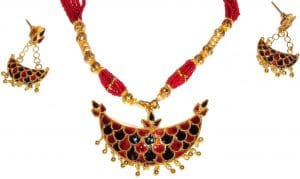
TRIBES OF ASSAM
Dimasa Tribe
The people of Dimasa tribe wear very colorful dresses especially the women folk who like to wear brightly colored Rigu, a form of Mekhela Chador which is worn from the waist down reaching the ankles. Another piece of Rigu also called the Bathormai which has only one design on the whole piece of cloth and is worn widely during summers. The male fraternity of the Dimasa tribe has a very simple clothing.
Bodo tribe
Like the Dimasas, the Bodo tribe people are also simple dressers but who love wearing colorful pieces of clothing that helps their inner beauty come to the fore. The most common form of women’s clothing worn by the Bodos is the Dokhona worn running down from their chest to the bottom.
Rabha tribe
The Rabha community like to follow the latest fashion trends and are still deeply rooted in their age-old traditions. The Rabhas have a unique sense of dressing which can be witnessed from their colorful display of colorful clothing with exquisite patterns running criss-cross around the garment.
Mishing tribe
The men of Mishing tribe wear a special type of dhoti called the Gonru Ugon worn from the waist down and a shirt called the Mibu Galuk covering the upper part of the body. The Mishing women unlike other tribes have a very simple clothing style and mostly wear the Mekhela Chador also called the Yakan Age-Gasar which is mostly black in color.
Deori Tribe
The male community of Deori tribe prefers a simple dressing style mostly wearing an “Ikhoon” a kind of dhoti and a shirt or a sporting complementing with the Ikhoon.
ART AND CULTURE OF ASSAM
Folk Music
It is not a surprise that Assam is rich in folk music. From the time of the Kamarupa Kingdom followed by Ahom Dynasty, Assamese culture has been influenced by each of its rulers except the British rule which ended the Ahom Dynasty. The indigenous folk music has influenced the folk music of artists like Bhupen Hazarika, Parvati Prasad Baruva, Jayanta Hazarika, Utpalendu Choudhury, Nirmalendu Choudhury and many others. Classical Assamese music is divided into Borgeet and Ojapali which combines narrative singing with dancing. The music of Oja-pali has a raga system of clear traditional orientation.
Art and Craft
It’s been more than two thousand years that various traditional crafts have emerged in Assam. The traditional crafts like pottery and terracotta work, brass craft, jewellery making, musical instruments making, cane and bamboo craft, silk and cotton weaving, and Woodcraft are a major source of employment for the people of Assam.
Weaving is the most ancient of all the practices where even now women take pride in the possession and occupation in the handloom industry. Gandhiji lauded the Assamese weavers as artists who could weave dreams in their looms. Various ethnocultural groups make exclusive types of cotton garments with embroidery designs and colour combinations.
Painting is another ancient form which has been known since the time of Chinese traveler Xuanzang (7th century CE). Most of the manuscripts from the Middle Ages have excellent examples of traditional paintings. They have been influenced by the concept and designs in the medieval works such as the Chitra Bhagawata. There is a Department of Fine Arts in Assam, called University Silchar, which is a central government organization which focuses on the art and craft of north east India with a particular reference to Assam.
Festivals
Assam is full of festivals, the most important being the Bihu. It is celebrated to mark the important points of a cultivator’s life over a yearly cycle. A non-religious festival which is celebrated irrespective of caste and creed. Rongali or Bohag Bihu celebrated in mid-April with the coming of spring and the beginning of the sowing season. It is also known as Rangaali Bihu (“rang” means merry-making). Next is the Kangaali Bihu (kangaali meaning poor) is celebrated in mid-October. It is called so because by this time the harvest is brought home. The Magh Bihu is celebrated in mid-January. There are community feasts and bonfires which take place. Also known as the Bhogaali Bihu (“bhog” means enjoyment and feasting). The first day of rongali bihu’ is called Goru Bihu when the cows are taken to the nearby ponds to be bathed.
Ali-Ai-Ligang is the spring festival, and the name of the festival is made up of three terms- ‘Ali’, root and seed, ‘Ai’ means fruit and ‘Ligang’, to sow.
Traditional Dance
Ojapali, Devdasi, and Satriya are the major dancing styles of Assam. Oja or the lead dancer narrates a mythological story along with the fusion of dance and acting. It is of three types – biyah-gowa that presents Mahabharata stories with the rhythmic use of feet, sukananni which celebrate the worship of snake goddess Manasa, and ramayani is based on the Assamese version of Ramayana. Satriya, developed by Sankardeva. Devadasi – deva-nati or nati nas is a conventional temple dance that is performed by unmarried women who submitted their lives to the presiding deity.
The dances of the Bodos are associated with the Kherai Puja festival where Bagurumba dance is the most popular. Other folk dances are incomplete without the Jhumur performed by the Adivasis which is a synchronized dance of boys and girls to the sounds of drums and flute.
Cuisine
Assamese dishes are said to be less spicy than any other Indian dishes. Assamese are mostly non-vegetarian, and their staple diet is rice. Fish, chicken, duck and pigeon and pork are widely eaten and quite popular. Fish curry is another favourite which is prepared as a sour dish called Machor tenga. Baked fish wrapped in leaves with white mustard paste is a popular delicacy called Patot diya mas where ‘pat’ means leaf in Assamese. Dried fish is a traditional tribal cuisine. Mutton, duck pigeon and fowl are many of the varieties of meat preparations. The variance of rice are produced and prepared like Cheera (flattened rice), akhoi (parched paddy grain), muri (puffed rice), pithguri (pound rice), sandoh guri (fried, pound rice), komal saul and bora saul.
The presence of traditional ‘detoxifying’ appetizers like Khar is prepared by burning the stem of the banana tree. It has a specific flavor which is soothing for the tummy.
People who have a weakness for sweet won’t be disheartened one bit as the Assamese dish is incomplete without sweets and one of its specialties called pitha is made from rice. Til pitha (moulded sticky rice cake with black sesame filling), ghila pitha (fried rice cakes), sunga pitha (rice cake baked inside whole bamboo pieces), narikolor laaru (sweet coconut balls) and kol pitha (banana pancakes) are some of these delicacies of the Assamese cuisine.
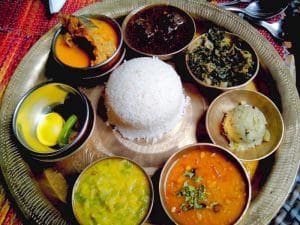
Tourism guide:- https://directortourism.assam.gov.in/portlets/approved-tourist-guides
The article was written by – Ms. Ayman Satopay. B.Sc in Textile and Apparel Design from Sir Vithaldas Thackersey College Of Home Science. Textile Value Chain intern. Email: tvcmedia.digital@gmail.com

